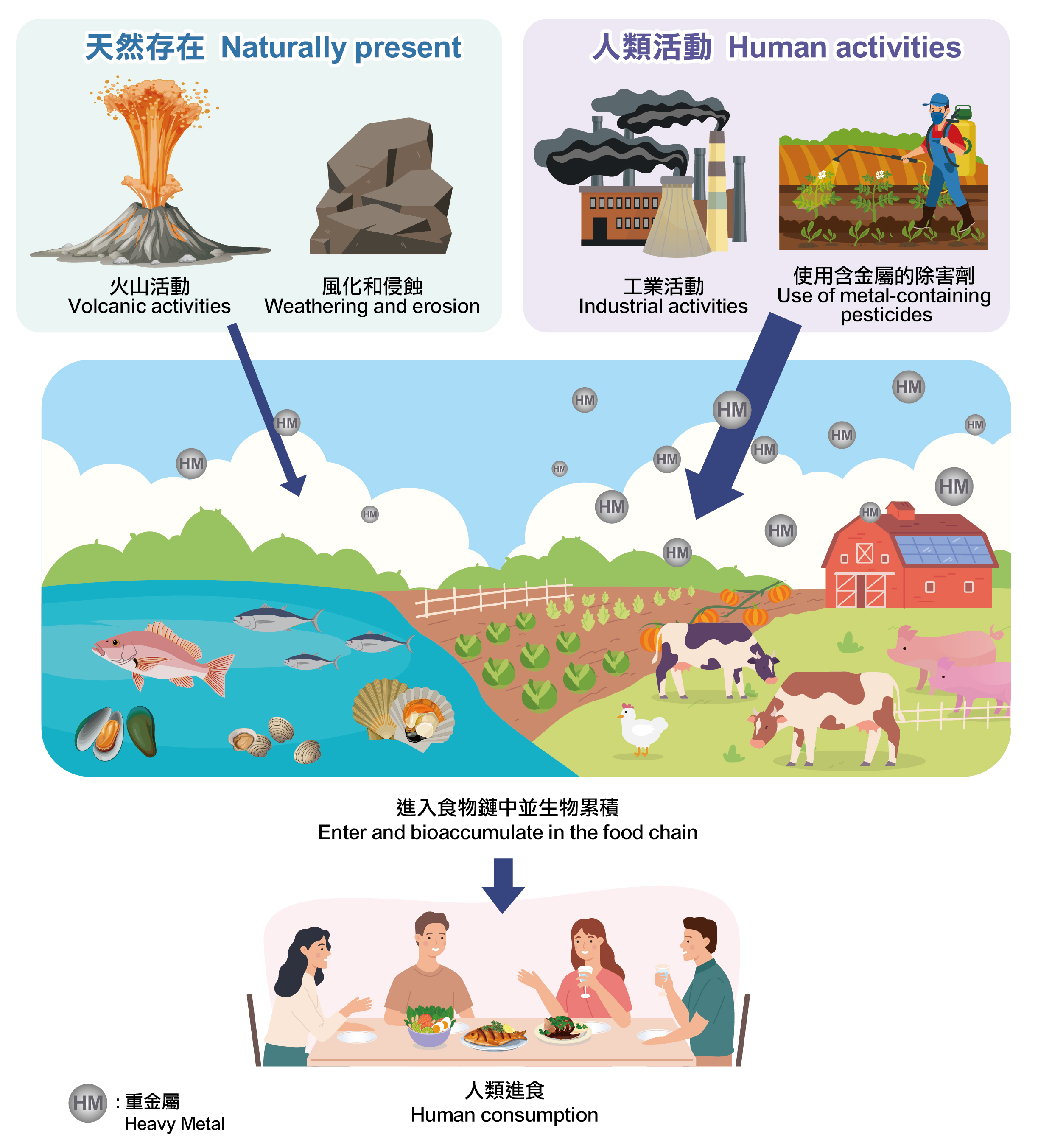
Food Safety Focus (216th Issue, July 2024) – Article 2
Keeping Our Food Safe: Understanding Metallic Contaminants in Food
Reported by Ms. Iris CHEUNG, Scientific Officer,
Risk Assessment Section, Centre for Food Safety
Food such as grains, meat and vegetables are an essential part of the human diet. They provide crucial nutrients that our bodies need for growth, repair of tissues and even the production of antibodies to fight off illness. However, the potential presence of toxic heavy metals is a food safety concern. They can enter the food chain as a result of environmental contamination or during the food production process. Past studies have found high levels of heavy metals in the internal organs of cattle and sheep in the United Kingdom. Understanding the sources and prevalence of heavy metals in our food supply are crucial for safeguarding public health. Let's take a closer look at this concerning issue.
Sources of Heavy Metals in Food
Heavy metals are natural substances that are ubiquitous in the environment. They are fundamental elemental components of the Earth's crust and naturally exist in rocks, soil and water. As these heavy metals get into the soil and water, they are easily taken up by the plants, animals and aquatic life that we consume. This makes the presence of metallic contaminants in our food, in most cases, unavoidable.
Human activities, however, can significantly increase the levels of heavy metals in the environment. These activities include metal mining, the use of metal containing fertilizers, pesticides and insecticides, and various industrial processes. When food is grown in polluted environments or when contaminated ingredients are used in food production, these harmful substances can accumulate in the food chain, potentially posing a direct threat to human health.
 Figure : How heavy metals get into our diets
Figure : How heavy metals get into our diets
Adverse Health Effects of Heavy Metals
While some heavy metals like copper, chromium, manganese and selenium are essential for the proper functioning of our bodies in trace amounts, some other heavy metals serve no functional purpose and are harmful to living organisms in even minute concentrations. Long term exposure to these heavy metals through the diet can lead to a range of serious health problems.
Among the metallic contaminants which may be found in food, the World Health Organization (WHO) has identified four as major public health concerns due to their toxicity, especially with long-term exposure. These are arsenic, cadmium, lead and mercury. Chronic exposure to lead may lead to reduction of intelligence quotient (IQ) in children and increased blood pressure in adults. Mercury exists in several forms, i.e. metallic, inorganic and organic. The organic form known as methylmercury is more toxic than inorganic mercury. Exposure to methylmercury, particularly for fetuses, infants and children, can impair neurological development and result in developmental delays, behavioral issues and learning problems. Arsenic and cadmium are classified as human carcinogens (Group 1) by the International Agency for Research on Cancer, meaning they can increase the risk of certain types of cancer. Cadmium accumulates mainly in the kidneys and may lead to irreversible kidney dysfunction. High intake of cadmium can also disrupt calcium metabolism and lead to the formation of kidney stones.
How are Heavy Metals in Food Being Regulated?
Governments and international organisations have established mechanisms to monitor and regulate the amounts of heavy metals in food because they are aware of the possible health concerns associated with the consumption of food contaminated with heavy metals. The Codex Alimentarius Commission (CAC), an international organisation established jointly by the Food and Agriculture Organization of the United Nations (FAO) and the WHO, has developed detailed guidelines on setting the maximum levels of heavy metals across a wide range of food commodities.
In Hong Kong, the Food Adulteration (Metallic Contamination) Regulations (Cap. 132V) sets out maximum levels (MLs) for metallic contaminants in various types of foods, which are of significance to the public. To protect public health and facilitate the international trade of food, we have observed the Agreement on the Application of Sanitary and Phytosanitary Measures and proposed to align our standards for metallic contaminants in food with the Codex standards as far as possible. Besides, the Centre for Food Safety (CFS) collects food samples under the food surveillance programme at import, wholesale and retail levels for testing various parameters including metallic contaminants. Immediate follow up actions will be undertaken for any unsatisfactory sample to safeguard public health.
What the Food Trade and Consumers Should Do
Although we cannot completely eliminate these metallic contaminants, their levels should be kept as low as reasonably achievable. Food producers should adopt best practices such as Good Agricultural Practice (GAP) and Good Manufacturing Practice (GMP). As consumers, we can do our part by buying food from reliable retailers and maintain a balanced diet to avoid excessive exposure to metallic contaminants from a small range of food items.

